How To Create A Timeline In Word 2011
Thirty Years of AIDS: A Timeline of the Epidemic
By Lisa Cisneros
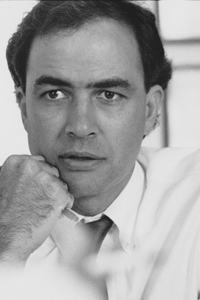
UCSF's Paul Volberding, MD, saw his first HIV-positive patient in July 1981. Photo by David Powers
Thirty years into the fight against HIV/AIDS, UCSF has helped change the course of this deadly disease, which has claimed the lives of 33 million people worldwide. This timeline covers the highlights over the past three decades at UCSF, in the nation and around the world.
Editor's note: This timeline was updated on March 23, 2012.
1981
- AIDS is detected in California and New York. The first cases are among gay men, then injection drug users.
- UCLA's Michael Gottlieb, MD, authored the first report to the US Centers for Disease Control (CDC) and Prevention on June 5 identifying the virus that would be known as AIDS.
- UCSF's Paul Volberding, MD, saw his first HIV-positive patient with Kaposi's sarcoma, a rare cancer later linked to AIDS, on his first day at San Francisco General Hospital (SFGH) on July 1.
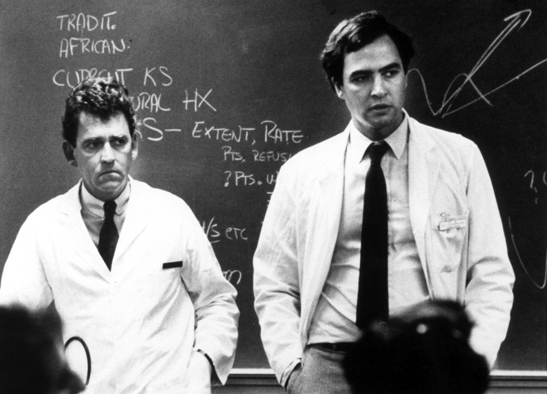
UCSF's Marcus Conant, MD, and Paul Volberding, among the first physicians to diagnose and treat patients with Acquired Immune Deficiency Syndrome (AIDS), discuss Kaposi's Sarcoma, in 1981. That year, Conant founded a Kaposi's sarcoma clinic, one of the nation's first specialized AIDS practices.
1982
- The CDC establishes the term Acquired Immune Deficiency Syndrome (AIDS).
- The City and County of San Francisco, working closely with health professionals at UCSF, SFGH, the San Francisco AIDS Foundation and others, develops the San Francisco "model of care," which emphasizes home and community-based services.
- US Congress convenes first hearings on HIV/AIDS.
1983
- UCSF faculty physicians develop the country's first outpatient AIDS clinic and inpatient ward at SFGH, which was the first unit of its kind in the US and remains a national model of care.
- Three thousand AIDS cases are reported in the US; 1,000 people have died so far.
- UCSF virologist Jay Levy, MD, co-discovers HIV; he and his colleagues go on to make many of the first observations in AIDS research, including demonstrating that HIV grew in cells other than in the lymphocytes and isolating the virus in the brain and the bowels.
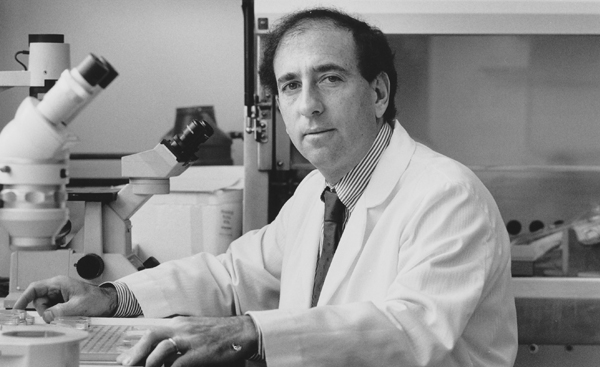
UCSF's Jay Levy, MD, was one of the first scientists to isolate the virus responsible for AIDS. Photo by David Powers
1984
- Ryan White, a 13-year-old hemophiliac from Indiana, becomes infected with HIV from a contaminated blood treatment.
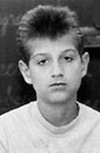
Ryan White
1985
- UCSF's Donald Abrams, MD, is instrumental in establishing a network of Bay Area clinicians called Community Consortium, which pioneers a new model of community-based clinical trials.
- The US Food and Drug Administration (FDA) licenses first HIV test for screening blood supplies.
- Movie star Rock Hudson announces that he has AIDS and dies, becoming the first major celebrity to succumb to the disease.
- The US Department of Health and Human Services and the World Health Organization (WHO) host the First International AIDS Conference in Atlanta. These annual conferences continue today.
- Ryan White is barred from school and becomes a national spokesperson against AIDS stigma and discrimination.
- American Foundation for AIDS Research is founded with the help of movie star Elizabeth Taylor.
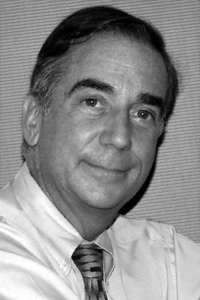
Donald Abrams, MD
1986
- With the awarding of a National Institutes of Mental Health AIDS Center grant designed to boost AIDS prevention research, UCSF's Center for AIDS Prevention officially opens its doors under the direction of Stephen Hulley, MD.
- The San Francisco AIDS Foundation launches the San Francisco AIDS Walk to raise funds for patient care, research and education. UCSF participates in the walk from the start.
- More than 38,000 cases of AIDS are reported from 85 countries.
- Elected in late 1980, President Ronald Reagan first mentions the word AIDS in public.
- National Academy of Sciences report is critical of US response to the epidemic and calls for $2 billion investment to combat the disease.
- The first clinical trials of antiviral drug azidothymidineor AZT begin.
- US Surgeon General Everett Koop, MD, issues report on AIDS calling for education and condom use.
- Institute of Medicine report calls for expanding education campaign and creating the National Commission on AIDS.
1987
- UCSF's Donald Abrams, MD, confirms, with the help of the Community Consortium of Bay Area physicians, that giving the drug pentamidine in aerosol form was a more effective way of treating a serious from of pneumonia that typically strikes AIDS patients.
- FDA approves AZT for treating AIDS.
- CDC launches first public service announcements about AIDS.
- AIDS memorial quilt displayed for the first time at the National Mall in Washington, DC.
- US adds HIV as a "dangerous contagious disease" to its immigration exclusion list
1988
- A group of UCSF researchers, including Diane Wara, MD, design a study that involved treating mothers with AZT from the second trimester onward, as well as at the time of delivery, and treating the infant with oral AZT. The study proved enormously effective, and reduced mother-to-infant transmission from 26 percent to 8 percent.
- WHO declares first World AIDS Day on December 1, which continues today.
- The City and County of San Francisco establishes what becomes the nation's largest needle exchange program.
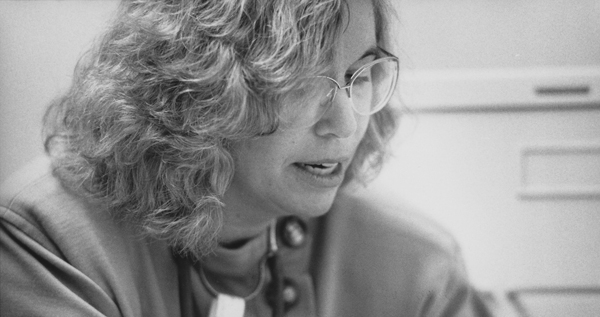
UCSF's Diane Wara, MD, was among the first physicians to describe AIDS in children and one of first to show how AIDS was being transmitted from mother to child. Photo by David Powers
1989
- UCSF's Paul Volberding, MD, finds that HIV-infected patients without symptoms of AIDS could have those symptoms delayed if they took the AZT.
- Congress creates the National Commission on AIDS.
- AIDS activists come out to protest about AIDS drugs, including demonstrating on San Francisco's Golden Gate Bridge.
1990
- FDA approves use of AZT for pediatric AIDS.
- Americans with Disabilities Act enacted by Congress prohibits discrimination against individuals with disabilities, including those infected with HIV/AIDS.
- Congress passes the Ryan White Care Act, shortly before his death. The act will be reauthorized in 2006 and again in 2009; Ryan White programs become the largest provider of services for people living with HIV/AIDS in the US.
1991
- UCSF's Nancy Padian, PhD, MPH, finds that HIV is much more likely to be passed sexually from males to females than vice versa and confirms the conclusion with a 10-year study of heterosexual transmission of the disease.
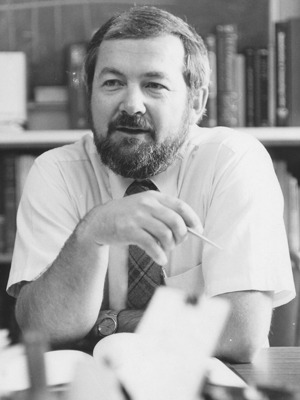
Merle Sande, MD. Photo by David Powers
- Ryan White dies of AIDS at age 18 – a month before his high school graduation.
- US introduces Red ribbon as the international symbol of AIDS awareness at the Tony Awards on Broadway.
- Freddie Mercury, lead singer of the rock band Queen, dies of AIDS.
- Los Angeles Lakers basketball great Earvin "Magic" Johnson retires abruptly after announcing that he had contracted HIV, but returned to play in the 1992 All-Star Game, winning the All-Star MVP Award.
1992
- AIDS becomes the No. 1 killer of US men ages 25 to 44.
- Tennis star Arthur Ashe announces he has AIDS.
1993
- UCSF's Merle Sande, MD, proves instrumental in bringing together the State of California, the City and County of San Francisco, UCSF, SFGH, and the Gladstone Foundation to build and fund the Gladstone Institute of Virology and Immunology (GIVI), a research institute dedicated to the study of virology and immunology with a focus on HIV and AIDS.
- The Women's Interagency HIV Study and HIV Epidemiology Study begin; both are major US federally funded research studies on HIV/AIDS.
- CDC initiates HIV prevention community planning process for local distribution of federal prevention funding.
1994
- UCSF's Ruth Greenblatt, MD, and her team create the Women's HIV Program (WHP), an innovative, multidisciplinary program specifically for women, designed to meet their unique health issues.
- AIDS becomes leading cause of death for all Americans ages 25 to 44.
- Elizabeth Glaser, founder of the Pediatric AIDS Foundation, dies of AIDS.
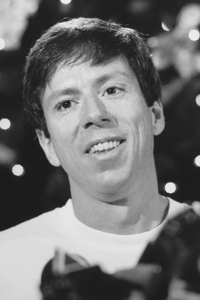
Jeff Getty
1995
- Jeff Getty, a prominent AIDS activist, receives the first bone-marrow transplant from a baboon to treat the disease at SFGH. In that procedure, cells taken from a baboon were transplanted into Getty with the hope that the primate's natural AIDS resistance would boost his immune system.
1996
- UCSF establishes the AIDS Research Institute (ARI) to coordinate and integrate all of the University's AIDS research activities among more than 60 programs and laboratories with hundreds of scientists from all four professional schools and affiliated labs and institutions, stimulating innovation and supporting interdisciplinary collaboration aimed at all aspects of the epidemic domestically and in at least 67 countries around the world.
- The number of new AIDS cases diagnosed in the US declines for the first time in history of the epidemic.
1997
- UCSF's Donald Abrams, MD, submits request to National Institute on Drug Abuse for a study on potential toxicity of medical marijuana, which was approved in 1998. He later finds that cannabis is helpful for relieving pain in patients with AIDS.
- AIDS-related deaths in the US decline by more than 40 percent compared to 1996, largely due to Highly Active Antiretroviral Therapy (HAART.)
- President Bill Clinton announces goal of finding a vaccine in 10 years.
1999
- Reggie Williams, founder of the National Task Force on AIDS Prevention, dies of AIDS.
2000
- US and United Nations security councils each declare HIV/AIDS a security threat.
- President Clinton issues an executive order to assist developing countries in importing and producing generic forms of HIV/AIDS drugs; creates first-ever Presidential Envoy for AIDS Cooperation.
2001
- UCSF's Nancy Padian, PhD, MPH, director of international programs at UCSF's AIDS Research Institute, establishes the UCSF Women's Global Health Imperative and builds a portfolio of more than 20 research projects in India, Mexico, San Francisco, South Africa and Zimbabwe.
- Merle Sande, MD, co-founds and co-directs the Academic Alliance for AIDS Care and Prevention in Africa, a unique public-private partnership that comprises faculty from Makerere University in Kampala, Uganda, and faculty from UCSF and several other medical institutions in North America.
- Manufacturers of generic drugs offer to produce discounted forms of HIV/AIDS drugs for developing countries.
2002
- The Global Fund to Fight AIDS, Tuberculosis and Malaria begins operations and approves first round of grants led by founding director Richard Feachem, KBE, DSc (Med), PhD, now interim director of UCSF's Global Health Sciences.
- The Bill & Melinda Gates Foundation awards $28 million to test whether the diaphragm can prevent the transmission of HIV, to UCSF's Women's Global Health Imperative, directed by Nancy Padian, PhD, MPH. The study enrolls women at two sites in South Africa and one in Zimbabwe.
- UNAIDS reports that women comprise about half of all adults living with HIV/AIDS worldwide.
- HIV is leading cause of death worldwide among those aged 15 to 59.
2003
- President George W. Bush announces the President's Emergency Plan for AIDS Relief (PEPFAR), a five-year, $15 billion initiative to address HIV/AIDS, tuberculosis and malaria primarily in countries hardest hit by these diseases.
- The William J. Clinton Presidential Foundation secures price reductions for HIV/AIDS drugs from manufacturers of generic drugs for developing countries.
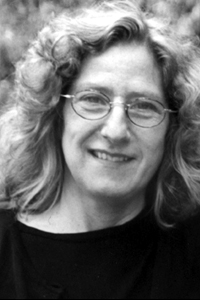
Nancy Padian, PhD, MPH
2004
- UNAIDS launches the Global Coalition on Women and AIDS to raise visibility of the epidemic's impact on women and girls.
- President Bush's PEPFAR begins awarding funds.
2005
- WHO, UNAIDS and Global Fund to Fight AIDS, Tuberculosis and Malaria announce joint efforts to increase availability of antiretroviral drugs in developing countries.
2006
- Scientists in the lab of Warner Greene, MD, PhD, director of the UCSF-affiliated GIVI identify a previously unknown function of APOBEC3G (A3G), a protein that acts against HIV, a finding that explains why CD4 T cells – the immune system cells targeted by HIV – are sometimes so susceptible to HIV infection and at other times are highly resistant.
- Jeff Getty, the AIDS activist who in 1995 received the first bone-marrow transplant from a baboon to treat the disease at SFGH, dies on Oct. 9. He was 49.
2007
- Warner Greene, MD PhD, director of GIVI, is appointed president of the Academic Alliance Foundation, an organization dedicated to fighting HIV/AIDS and other infectious diseases in Africa by establishing and supporting programs of training, prevention and care.
- WHO and UNAIDS issue new recommendation for provider-initiated HIV testing in health care settings.
2008
- CDC releases new HIV incidence estimates for the US, showing the epidemic is worse than previously thought.
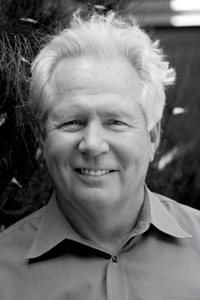
Warner Greene, MD PhD. Photo by Cindy Chew
2009
- President Barack Obama launches the Global Health Initiative, a six-year, $63-billion effort to develop a comprehensive approach to address global health in low- and middle-income countries with PEPFAR as a key component of the plan.
- Obama Administration lifts the HIV travel and immigration ban, which takes effect in January 2010.
- Congress eliminates long-standing ban on the use of federal funding for needle exchange programs in the US.
2010
- US removes travel and immigration ban of HIV-positive individuals.
- Obama Administration releases first comprehensive National HIV/AIDS Strategy [PDF] in July. The primary goals of the strategy are reducing incidence, increasing access to care and optimizing health outcomes and reducing HIV-related health disparities.
2011
- June 5 marks three decades since the discovery of AIDS in the US.
- UCSF to participate in San Francisco AIDS Walk, which marks 25 years of fundraising to combat the disease, in Golden Gate Park on July 17.
- The US Health Resources and Services Administration funds the UCSF Center for AIDS Prevention Studiets to provide leadership and support to seven states implementing interventions to enhance HIV testing and diagnosis.
2012
- UCSF names Paul Volberding, MD, director of the AIDS Research Institute at UCSF and the director of research for the UCSF Global Health Sciences program on February 13.
- President Barack Obama appoints UCSF's Grant Colfax, MD, as the director of the Office of National AIDS Policy on March 14.
- UCSF faculty to present findings at the International AIDS Conference in Washington, DC, in July.
Sources:
The US Centers for Disease Control and Prevention
The Henry J. Kaiser Foundation Campaign: The Global HIV/AIDS Timeline
How To Create A Timeline In Word 2011
Source: https://www.ucsf.edu/news/2011/06/104134/thirty-years-aids-timeline-epidemic
Posted by: grissomfrinslazince.blogspot.com

0 Response to "How To Create A Timeline In Word 2011"
Post a Comment